AMD Threadripper Pro Review: An Upgrade Over Regular Threadripper?
by Dr. Ian Cutress on July 14, 2021 9:00 AM EST- Posted in
- CPUs
- AMD
- ThreadRipper
- Threadripper Pro
- 3995WX
CPU Tests: Encoding
One of the interesting elements on modern processors is encoding performance. This covers two main areas: encryption/decryption for secure data transfer, and video transcoding from one video format to another.
In the encrypt/decrypt scenario, how data is transferred and by what mechanism is pertinent to on-the-fly encryption of sensitive data - a process by which more modern devices are leaning to for software security.
Video transcoding as a tool to adjust the quality, file size and resolution of a video file has boomed in recent years, such as providing the optimum video for devices before consumption, or for game streamers who are wanting to upload the output from their video camera in real-time. As we move into live 3D video, this task will only get more strenuous, and it turns out that the performance of certain algorithms is a function of the input/output of the content.
HandBrake 1.32: Link
Video transcoding (both encode and decode) is a hot topic in performance metrics as more and more content is being created. First consideration is the standard in which the video is encoded, which can be lossless or lossy, trade performance for file-size, trade quality for file-size, or all of the above can increase encoding rates to help accelerate decoding rates. Alongside Google's favorite codecs, VP9 and AV1, there are others that are prominent: H264, the older codec, is practically everywhere and is designed to be optimized for 1080p video, and HEVC (or H.265) that is aimed to provide the same quality as H264 but at a lower file-size (or better quality for the same size). HEVC is important as 4K is streamed over the air, meaning less bits need to be transferred for the same quality content. There are other codecs coming to market designed for specific use cases all the time.
Handbrake is a favored tool for transcoding, with the later versions using copious amounts of newer APIs to take advantage of co-processors, like GPUs. It is available on Windows via an interface or can be accessed through the command-line, with the latter making our testing easier, with a redirection operator for the console output.
We take the compiled version of this 16-minute YouTube video about Russian CPUs at 1080p30 h264 and convert into three different files: (1) 480p30 ‘Discord’, (2) 720p30 ‘YouTube’, and (3) 4K60 HEVC.
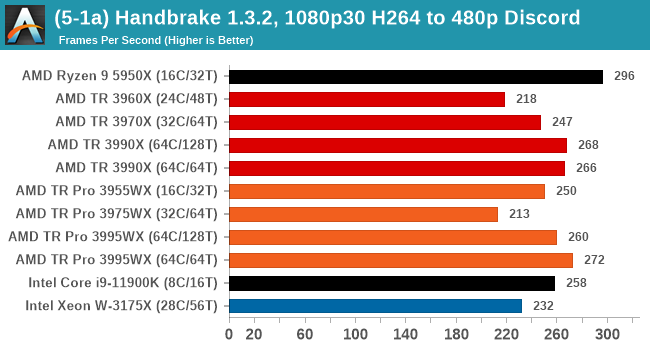
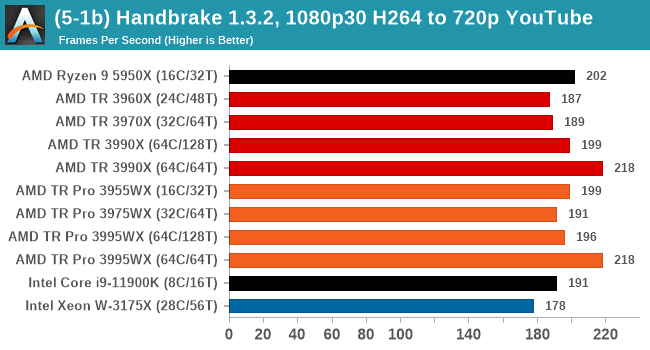
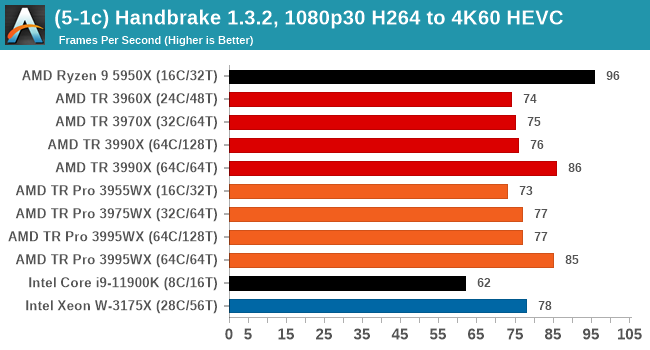
In every situation the R9 5950X does the best or near the best, but HB is one of those tests where running in 64C/64T mode does benefit the result by a good 10%. Otherwise there is little difference between TR and TR Pro.
7-Zip 1900: Link
The first compression benchmark tool we use is the open-source 7-zip, which typically offers good scaling across multiple cores. 7-zip is the compression tool most cited by readers as one they would rather see benchmarks on, and the program includes a built-in benchmark tool for both compression and decompression.
The tool can either be run from inside the software or through the command line. We take the latter route as it is easier to automate, obtain results, and put through our process. The command line flags available offer an option for repeated runs, and the output provides the average automatically through the console. We direct this output into a text file and regex the required values for compression, decompression, and a combined score.
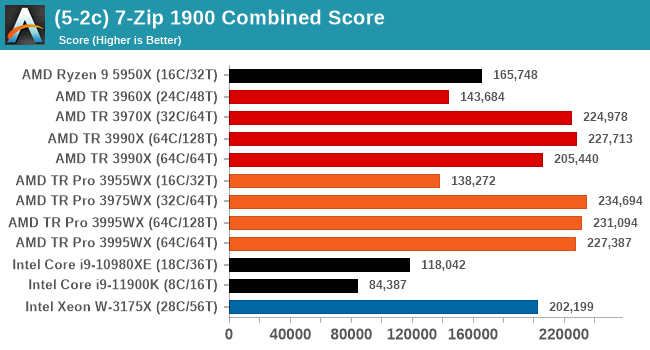
7-zip tends to like memory bandwidth as well as compute, however this test seems to top out at 64 threads, so any processor above that is scoring roughly the same. The 3990X result seems a little low, however.
AES Encoding
Algorithms using AES coding have spread far and wide as a ubiquitous tool for encryption. Again, this is another CPU limited test, and modern CPUs have special AES pathways to accelerate their performance. We often see scaling in both frequency and cores with this benchmark. We use the latest version of TrueCrypt and run its benchmark mode over 1GB of in-DRAM data. Results shown are the GB/s average of encryption and decryption.
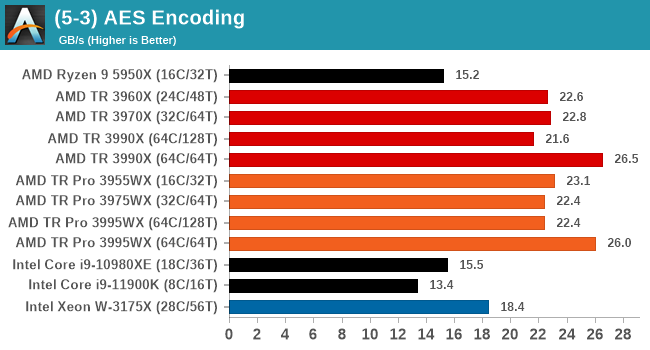
AES does like memory bandwidth, and the 64C/64T setting does best here.
WinRAR 5.90: Link
For the 2020 test suite, we move to the latest version of WinRAR in our compression test. WinRAR in some quarters is more user friendly that 7-Zip, hence its inclusion. Rather than use a benchmark mode as we did with 7-Zip, here we take a set of files representative of a generic stack
- 33 video files , each 30 seconds, in 1.37 GB,
- 2834 smaller website files in 370 folders in 150 MB,
- 100 Beat Saber music tracks and input files, for 451 MB
This is a mixture of compressible and incompressible formats. The results shown are the time taken to encode the file. Due to DRAM caching, we run the test for 20 minutes times and take the average of the last five runs when the benchmark is in a steady state.
For automation, we use AHK’s internal timing tools from initiating the workload until the window closes signifying the end. This means the results are contained within AHK, with an average of the last 5 results being easy enough to calculate.
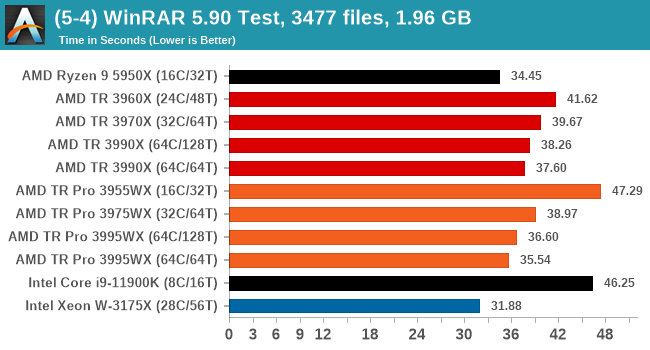
In this test we're looking for the smallest bars representing the lowest time, and 64C/64T has a slight advantage over the full 128T modes. There seems to be no real difference between TR and TR Pro here though - normally WinRAR likes having memory bandwidth, but it seems that there is enough to go around.


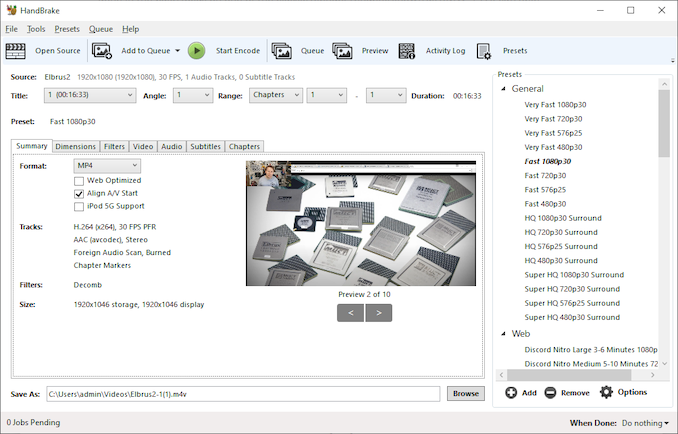
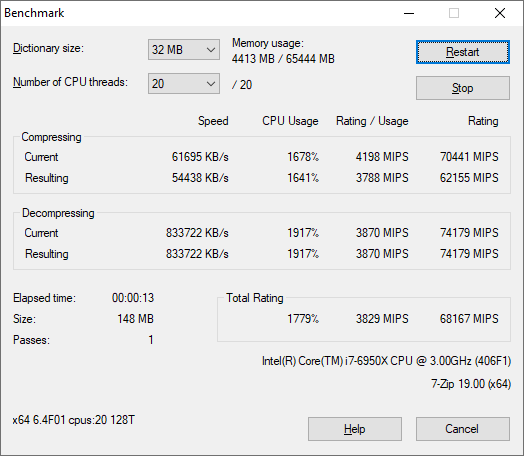
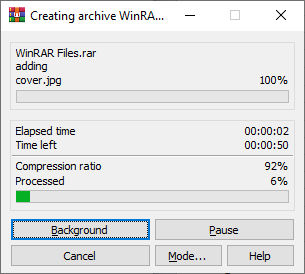








98 Comments
View All Comments
Qasar - Tuesday, July 27, 2021 - link
sorry but that is not HEDT, workstation, sure. the last HEDT platform intel had was x299 and socket 2066socket 3647, is there server/workstation platform, but hey if you consider a US $3k cpu to be a HEDT processor, then that's your choice :-)
mode_13h - Monday, July 26, 2021 - link
> at least amd HAS a HEDT cpu, when was the last one from intel ?Intel is doing an Ice Lake workstation platform. Not sure if HEDT will follow.
mode_13h - Sunday, July 25, 2021 - link
> 7 days to AugustThe rumor was that it would be *announced* at some point in August. It didn't say when, in August, but the rumored ship date wasn't until sometime in September. But it's just a rumor.
croc - Monday, July 26, 2021 - link
MY point is that the BIOS updates usually happen about a month before the product announcement. Not to mention some benchmarks and other 'leaked' information. Y'know,,, Hype generation, direct from horsey's mouth. August announcement? Don't think so. Chagall? Possible, but would break convention, not that AMD really has any when it comes to code names...mode_13h - Monday, July 26, 2021 - link
> BIOS updates usually happen about a month before the product announcement.Before announcement or ship?
> Hype generation
Seems to me that it's not necessary, in this case. AMD will already have more demand than it can satisfy.
Qasar - Tuesday, July 27, 2021 - link
" Not to mention some benchmarks and other 'leaked' information "considering how few leaks and info have come out about amd's products as of late until quite close to release, im not surprised there is little info out there about zen 3 TR
" Hype generation "
which amd doesnt need all that much, their products are more interesting then intels right now, intel needs the hype, not amd ;-)
Mikewind Dale - Monday, July 19, 2021 - link
Given how much trouble Intel has had with their new process - even though Intel used to be the industry leader in fabrication - I suspect that if AMD had kept fabrication in-house, they'd be in serious trouble right.GlobalFoundries has also had trouble moving to a new, cutting-edge process. At the moment, they'd decided to stay one process behind TSMC, and cater to the portion of the market that doesn't need a cutting-edge process.
anakhizer - Monday, July 19, 2021 - link
The article is excellent! However, the ordering of data in the tables is absolutely terrible.Please figure out how to sort the tables in a more logical manner like performance. As the tables are they are pretty much unreadable if you want to get the performance numbers with a glance.
kensiko - Monday, July 19, 2021 - link
Performance wise, looking at all those graphs, the 5950x is such a great deal ! I really love my 5950x. I did love my TR1950x, it was not getting as hot at my 5950x. But no way I'm going back to Threadripper for just a home PC. Event at work I don't think we would get a Threadripper again, the Epyc gives what we want even if the frequency is a bit lower.mode_13h - Tuesday, July 20, 2021 - link
Threadripper still makes a lot of sense for people who have scalable workloads (or run lots of VMs) and who don't need the full memory bandwidth or PCIe lanes of EPYC or TR Pro.I personally wouldn't buy one, but they're popular for deep learning workstations and Linus Torvalds famously has one.